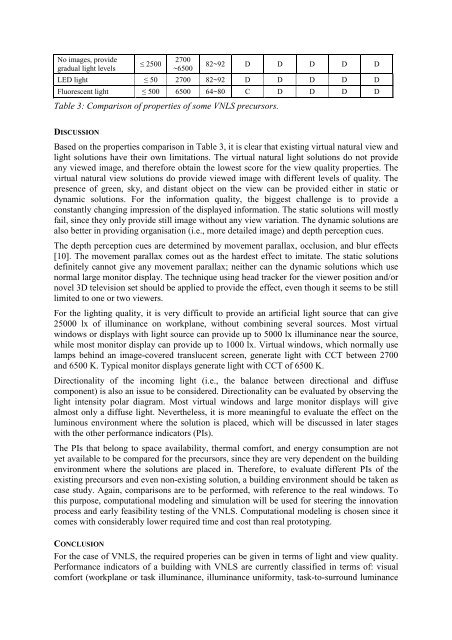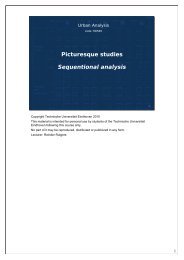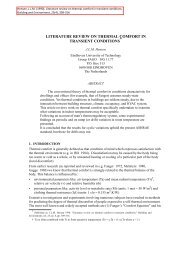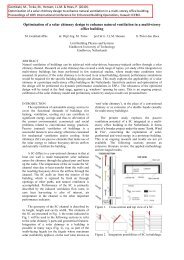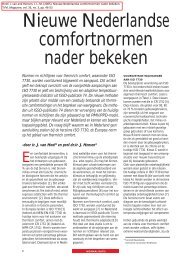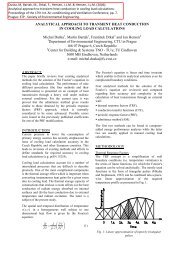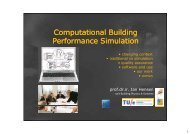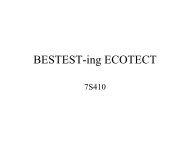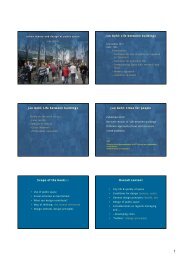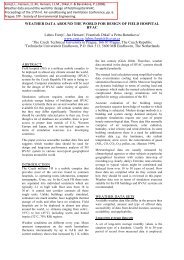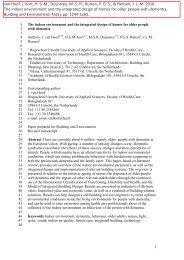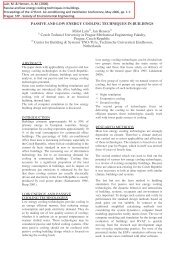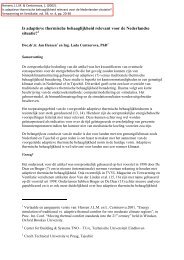properties and performance indicators of virtual natural lighting ...
properties and performance indicators of virtual natural lighting ...
properties and performance indicators of virtual natural lighting ...
You also want an ePaper? Increase the reach of your titles
YUMPU automatically turns print PDFs into web optimized ePapers that Google loves.
No images, providegradual light levels≤ 25002700~650082~92 D D D D DLED light ≤ 50 2700 82~92 D D D D DFluorescent light ≤ 500 6500 64~80 C D D D DTable 3: Comparison <strong>of</strong> <strong>properties</strong> <strong>of</strong> some VNLS precursors.DISCUSSIONBased on the <strong>properties</strong> comparison in Table 3, it is clear that existing <strong>virtual</strong> <strong>natural</strong> view <strong>and</strong>light solutions have their own limitations. The <strong>virtual</strong> <strong>natural</strong> light solutions do not provideany viewed image, <strong>and</strong> therefore obtain the lowest score for the view quality <strong>properties</strong>. The<strong>virtual</strong> <strong>natural</strong> view solutions do provide viewed image with different levels <strong>of</strong> quality. Thepresence <strong>of</strong> green, sky, <strong>and</strong> distant object on the view can be provided either in static ordynamic solutions. For the information quality, the biggest challenge is to provide aconstantly changing impression <strong>of</strong> the displayed information. The static solutions will mostlyfail, since they only provide still image without any view variation. The dynamic solutions arealso better in providing organisation (i.e., more detailed image) <strong>and</strong> depth perception cues.The depth perception cues are determined by movement parallax, occlusion, <strong>and</strong> blur effects[10]. The movement parallax comes out as the hardest effect to imitate. The static solutionsdefinitely cannot give any movement parallax; neither can the dynamic solutions which usenormal large monitor display. The technique using head tracker for the viewer position <strong>and</strong>/ornovel 3D television set should be applied to provide the effect, even though it seems to be stilllimited to one or two viewers.For the <strong>lighting</strong> quality, it is very difficult to provide an artificial light source that can give25000 lx <strong>of</strong> illuminance on workplane, without combining several sources. Most <strong>virtual</strong>windows or displays with light source can provide up to 5000 lx illuminance near the source,while most monitor display can provide up to 1000 lx. Virtual windows, which normally uselamps behind an image-covered translucent screen, generate light with CCT between 2700<strong>and</strong> 6500 K. Typical monitor displays generate light with CCT <strong>of</strong> 6500 K.Directionality <strong>of</strong> the incoming light (i.e., the balance between directional <strong>and</strong> diffusecomponent) is also an issue to be considered. Directionality can be evaluated by observing thelight intensity polar diagram. Most <strong>virtual</strong> windows <strong>and</strong> large monitor displays will givealmost only a diffuse light. Nevertheless, it is more meaningful to evaluate the effect on theluminous environment where the solution is placed, which will be discussed in later stageswith the other <strong>performance</strong> <strong>indicators</strong> (PIs).The PIs that belong to space availability, thermal comfort, <strong>and</strong> energy consumption are notyet available to be compared for the precursors, since they are very dependent on the buildingenvironment where the solutions are placed in. Therefore, to evaluate different PIs <strong>of</strong> theexisting precursors <strong>and</strong> even non-existing solution, a building environment should be taken ascase study. Again, comparisons are to be performed, with reference to the real windows. Tothis purpose, computational modeling <strong>and</strong> simulation will be used for steering the innovationprocess <strong>and</strong> early feasibility testing <strong>of</strong> the VNLS. Computational modeling is chosen since itcomes with considerably lower required time <strong>and</strong> cost than real prototyping.CONCLUSIONFor the case <strong>of</strong> VNLS, the required properies can be given in terms <strong>of</strong> light <strong>and</strong> view quality.Performance <strong>indicators</strong> <strong>of</strong> a building with VNLS are currently classified in terms <strong>of</strong>: visualcomfort (workplane or task illuminance, illuminance uniformity, task-to-surround luminance


